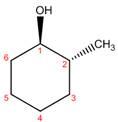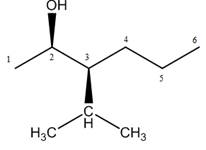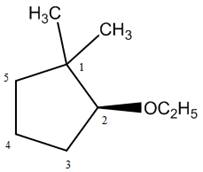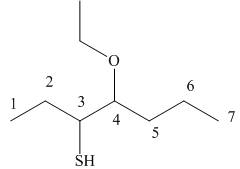
Concept explainers
(a)
Interpretation: The structure corresponding to the given name is to be drawn.
Concept introduction: To derive the structure of the compound from its IUPAC name, one should follow the given three steps. The first step involves the identification of parent name and
Answer to Problem 9.41P
The structure corresponding to the given name is,

Explanation of Solution
The name of the given compound is

Figure 1
The structure corresponding to the given name is shown in Figure 1.
(b)
Interpretation: The structure corresponding to the given name is to be drawn.
Concept introduction: To derive the structure of the compound from its IUPAC name, one should follow the given three steps. The first step involves the identification of parent name and functional group found at the end of the name. The second step is numbering of carbon skeleton in either direction. The third step is addition of substituents at appropriate carbon atoms.
Answer to Problem 9.41P
The structure corresponding to the given name is,

Explanation of Solution
The name of the given compound is

Figure 2
The structure corresponding to the given name is shown in Figure 2.
(c)
Interpretation: The structure corresponding to the given name is to be drawn.
Concept introduction: To derive the structure of the compound from its IUPAC name, one should follow the given three steps. The first step involves the identification of parent name and functional group found at the end of the name. The second step is numbering of carbon skeleton in either direction. The third step is addition of substituents at appropriate carbon atoms.
Answer to Problem 9.41P
The structure corresponding to the given name is,

Explanation of Solution
The name of the given compound is

Figure 3
The structure corresponding to the given name is shown in Figure 3.
(d)
Interpretation: The structure corresponding to the given name is to be drawn.
Concept introduction: To derive the structure of the compound from its IUPAC name, one should follow the given three steps. The first step involves the identification of parent name and functional group found at the end of the name. The second step is numbering of carbon skeleton in either direction. The third step is addition of substituents at appropriate carbon atoms.
Answer to Problem 9.41P
The structure corresponding to the given name is,

Explanation of Solution
The name of the given compound is

Figure 4
The structure corresponding to the given name is shown in Figure 4.
(e)
Interpretation: The structure corresponding to the given name is to be drawn.
Concept introduction: To derive the structure of the compound from its IUPAC name, one should follow the given three steps. The first step involves the identification of parent name and functional group found at the end of the name. The second step is numbering of carbon skeleton in either direction. The third step is addition of substituents at appropriate carbon atoms.
Answer to Problem 9.41P
The structure corresponding to the given name is,

Explanation of Solution
The name of the given compound is

Figure 5
The structure corresponding to the given name is shown in Figure 5.
(f)
Interpretation: The structure corresponding to the given name is to be drawn.
Concept introduction: To derive the structure of the compound from its IUPAC name, one should follow the given three steps. The first step involves the identification of parent name and functional group found at the end of the name. The second step is numbering of carbon skeleton in either direction. The third step is addition of substituents at appropriate carbon atoms.
Answer to Problem 9.41P
The structure corresponding to the given name is,

Explanation of Solution
The name of the given compound is

Figure 6
The structure corresponding to the given name is shown in Figure 6.
(g)
Interpretation: The structure corresponding to the given name is to be drawn.
Concept introduction: To derive the structure of the compound from its IUPAC name, one should follow the given three steps. The first step involves the identification of parent name and functional group found at the end of the name. The second step is numbering of carbon skeleton in either direction. The third step is addition of substituents at appropriate carbon atoms.
The naming of chiral center and geometric isomers are based on Cahn-Ingold-Prelog priority rules. If the priority assigned to each group attached to the chirality center in a molecule is in a clockwise direction, then it is the R-stereoisomer, and if this is counter-clockwise, then it is the S-stereoisomer. R and S-stereoisomer are mirror images of each other.
Answer to Problem 9.41P
The structure corresponding to the given name is,

Explanation of Solution
The name of the given compound is

Figure 7
The structure corresponding to the given name is shown in Figure 7.
(h)
Interpretation: The structure corresponding to the given name is to be drawn.
Concept introduction: To derive the structure of the compound from its IUPAC name, one should follow the given three steps. The first step involves the identification of parent name and functional group found at the end of the name. The second step is numbering of carbon skeleton in either direction. The third step is addition of substituents at appropriate carbon atoms.
The naming of chiral center and geometric isomers are based on Cahn-Ingold-Prelog priority rules. If the priority assigned to each group attached to the chirality center in a molecule is in a clockwise direction, then it is the R-stereoisomer, and if this is counter-clockwise, then it is the S-stereoisomer. R and S-stereoisomer are mirror images of each other.
Answer to Problem 9.41P
The structure corresponding to the given name is,

Explanation of Solution
The name of the given compound is

Figure 8
The structure corresponding to the given name is shown in Figure 8.
(i)
Interpretation: The structure corresponding to the given name is to be drawn.
Concept introduction: To derive the structure of the compound from its IUPAC name, one should follow the given three steps. The first step involves the identification of parent name and functional group found at the end of the name. The second step is numbering of carbon skeleton in either direction. The third step is addition of substituents at appropriate carbon atoms.
Answer to Problem 9.41P
The structure corresponding to the given name is,

Explanation of Solution
The name of the given compound is

Figure 9
The structure corresponding to the given name is shown in Figure 9.
(j)
Interpretation: The structure corresponding to the given name is to be drawn.
Concept introduction: To derive the structure of the compound from its IUPAC name, one should follow the given three steps. The first step involves the identification of parent name and functional group found at the end of the name. The second step is numbering of carbon skeleton in either direction. The third step is addition of substituents at appropriate carbon atoms.
Answer to Problem 9.41P
The structure corresponding to the given name is,

Explanation of Solution
The name of the given compound is

Figure 10
The structure corresponding to the given name is shown in Figure 10.
Want to see more full solutions like this?
Chapter 9 Solutions
Organic Chemistry
- Germanium (Ge) is a semiconductor with a bandgap of 2.2 eV. How could you dope Ge to make it a p-type semiconductor with a larger bandgap? Group of answer choices It is impossible to dope Ge and have this result in a larger bandgap. Dope the Ge with silicon (Si) Dope the Ge with gallium (Ga) Dope the Ge with phosphorus (P)arrow_forwardWhich of the following semiconductors would you choose to have photons with the longest possible wavelengths be able to promote electrons to the semiconductor's conduction band? Group of answer choices Si Ge InSb CdSarrow_forwardWhich of the following metals is the only one with all of its bands completely full? Group of answer choices K Na Ca Alarrow_forward
- 2. Specify the solvent and reagent(s) required to carry out each of the following FGI. If two reagent sets must be used for the FGI, specify the solvent and reagent(s) for each reagent set. If a reaction cannot be carried out with reagents (sets) class, write NP (not possible) in the solvent box for reagent set #1. Use the letter abbreviation for each solvent; use a number abbreviation for reagent(s). Solvents: CH2Cl2 (A); Reagents: H₂O (B); CH3CO₂H (D) NaHCO3 (4); Hg(OAc)2 (5); HBr (1); R₂BH (6); H2SO4 (2); CH3OH (C); Br₂ (3); H₂O₂ / HO- (7); NaBH4 (8) Reagent Set #1 Reagent Set #2 FGI OH - α-α Br + enant Solvent Reagent(s) Solvent Reagent(s)arrow_forwardBased on concepts from Lecture 3-5, which of the following ionic compounds should be most soluble in water? Group of answer choices MgO BeO CaO BaOarrow_forwardFrom an energy standpoint, which two process - in the correct order - are involved in the dissolving of an ionic compound crystal? Group of answer choices Water coordination to the ions followed by sublimation into the gas phase Sublimation of the crystal into gas-phase ions followed by water coordination to the ions Ion dissociation from the crystal followed by water coordination to the ions Water coordination to the ions followed by ion dissociation from the crystalarrow_forward
- For which Group 2 metal (M), is this process the most exothermic? M2+(g) + O2−(g) + CO2(g) → MO(s) + CO2(g) Group of answer choices M = Sr M = Mg M = Ca M = Baarrow_forward2. Specify the solvent and reagent(s) required to carry out each of the following FGI. If two reagent sets must be used for the FGI, specify the solvent and reagent(s) for each reagent set. If a reaction cannot be carried out with reagents (sets) class, write NP (not possible) in the solvent box for reagent set #1. Use the letter abbreviation for each solvent; use a number abbreviation for reagent(s). Solvents: CH2Cl2 (A); H₂O (B); Reagents: HBr (1); H2SO4 (2); CH3OH (C); Br₂ (3); CH3CO₂H (D) NaHCO3 (4); Hg(OAc)2 (5); R₂BH (6); H₂O₂ / HO- (7); NaBH4 (8) Reagent Set #1 Reagent Set #2 FGI Solvent Reagent(s) Solvent Reagent(s) HO OHarrow_forwardFor which of the following ionic compounds would you expect the smallest difference between its theoretical and experimental lattice enthalpies? (You may assume these all have the same unit cell structure.) Electronegativities: Ca (1.0), Fe (1.8), Mg (1.2), O (3.5), S (2.5), Zn (1.6) Group of answer choices ZnO MgS CaO FeSarrow_forward
- In the Born-Haber cycle for KCl crystal formation, what enthalpy component must be divided by two? Group of answer choices KCl(s) enthalpy of formation Ionization energy for K(g) K(s) sublimation enthalpy Cl2 bond dissociation enthalpyarrow_forward2. Specify the solvent and reagent(s) required to carry out each of the following FGI. If two reagent sets must be used for the FGI, specify the solvent and reagent(s) for each reagent set. If a reaction cannot be carried out with reagents (sets) class, write NP (not possible) in the solvent box for reagent set #1. Use the letter abbreviation for each solvent; use a number abbreviation for reagent(s). Solvents: CH2Cl2 (A); H₂O (B); Reagents: HBr (1); R₂BH (6); H2SO4 (2); CH3OH (C); Br₂ (3); CH3CO₂H (D) NaHCO3 (4); Hg(OAc)2 (5); H₂O₂ / HO (7); NaBH4 (8) Reagent Set #1 Reagent Set #2 FGI хот Br Solvent Reagent(s) Solvent Reagent(s)arrow_forwardWhat is the correct chemical equation for the lattice formation reaction for CaBr2? Group of answer choices Ca2+(g) + 2 Br−(g) → CaBr2(s) ½ Ca2+(g) + Br−(g) → ½ CaBr2(s) Ca(s) + Br2(l) → CaBr2(s) Ca(s) + 2 Br−(g) → CaBr2(s)arrow_forward
 ChemistryChemistryISBN:9781305957404Author:Steven S. Zumdahl, Susan A. Zumdahl, Donald J. DeCostePublisher:Cengage Learning
ChemistryChemistryISBN:9781305957404Author:Steven S. Zumdahl, Susan A. Zumdahl, Donald J. DeCostePublisher:Cengage Learning ChemistryChemistryISBN:9781259911156Author:Raymond Chang Dr., Jason Overby ProfessorPublisher:McGraw-Hill Education
ChemistryChemistryISBN:9781259911156Author:Raymond Chang Dr., Jason Overby ProfessorPublisher:McGraw-Hill Education Principles of Instrumental AnalysisChemistryISBN:9781305577213Author:Douglas A. Skoog, F. James Holler, Stanley R. CrouchPublisher:Cengage Learning
Principles of Instrumental AnalysisChemistryISBN:9781305577213Author:Douglas A. Skoog, F. James Holler, Stanley R. CrouchPublisher:Cengage Learning Organic ChemistryChemistryISBN:9780078021558Author:Janice Gorzynski Smith Dr.Publisher:McGraw-Hill Education
Organic ChemistryChemistryISBN:9780078021558Author:Janice Gorzynski Smith Dr.Publisher:McGraw-Hill Education Chemistry: Principles and ReactionsChemistryISBN:9781305079373Author:William L. Masterton, Cecile N. HurleyPublisher:Cengage Learning
Chemistry: Principles and ReactionsChemistryISBN:9781305079373Author:William L. Masterton, Cecile N. HurleyPublisher:Cengage Learning Elementary Principles of Chemical Processes, Bind...ChemistryISBN:9781118431221Author:Richard M. Felder, Ronald W. Rousseau, Lisa G. BullardPublisher:WILEY
Elementary Principles of Chemical Processes, Bind...ChemistryISBN:9781118431221Author:Richard M. Felder, Ronald W. Rousseau, Lisa G. BullardPublisher:WILEY





